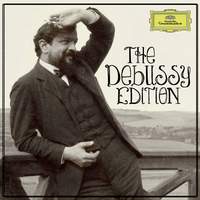Recording of the Week,
Claude Debussy
This year marks the 150th anniversary of French composer Claude Debussy’s birth, and is therefore the perfect opportunity for those wishing to get to know more of his music. Such anniversaries always provide a good excuse for record labels to raid their back catalogues, and three boxed sets released today certainly do not disappoint on that front, with two enormous collections from Deutsche Grammophon and Sony, each consisting of the majority of his compositions spread across eighteen CDs, and a six-disc box of the complete piano music from Decca. With such a large number of discs, I can’t possibly go into as much detail as I would like about the minutiae of each set, but perhaps the best thing I can do is to share with you some highlights that jumped out at me during my listening, and then you can make your own mind up about which one to buy!

It is often said that the opening flute phrase of Prélude à l’après-midi d’un faune is among a handful of compositions (along with the tonally-ambiguous chord heard at the start of Wagner’s Tristan und Isolde) that herald the beginning of modernism in music. As Pierre Boulez observes, “the flute of the faun brought new breath to the art of music”. Along with La Mer it is undoubtedly among Debussy’s best-known works, and is an ideal starting point for those unfamiliar with his music. You’ll be pleased to hear that all of these cornerstones are served well in both sets, with Boulez conducting the Cleveland Orchestra in most of the major orchestral works for DG, and a more eclectic collection of conductors doing the honours for Sony, including Charles Munch, Michael Tilson Thomas, Marek Janowski and Leonard Bernstein. Interestingly, Boulez conducts the three Nocturnes on both sets, albeit in different recordings (Cleveland for DG, and an earlier recording with the New Philharmonia Orchestra for Sony). It is fascinating to hear the tiny changes of approach between the two recordings, separated as they are by a gap of twenty-five years. I had a very slight preference for his later, Cleveland version, occasionally finding the earlier performance just a touch too limpid in the central movement, Fêtes, but I’m being extremely picky here.
The Sony box also contains such fine recordings as Boulez’s classic account of Debussy’s only opera, Pelléas et Mélisande with George Shirley, Elisabeth Söderström and Donald McIntyre, which is perhaps as ideal a recording of this often-impenetrable piece as one could ask for. I also very much enjoyed getting to know the incidental music for the five-act mystery play, Le Martyre de Saint Sébastien, performed for Sony by Michael Tilson Thomas conducting the London Symphony Orchestra, although I must admit that I could really have done with a little less of the spoken text from the play that has been included on this recording, as on repeated listenings it started to grate somewhat (the Ernest Ansermet recording in the DG box is mercifully free from such interpolations).
For my money, when it comes to the piano music, DG’s set has the advantage, with performers such as Krystian Zimerman, Michelangeli and Zoltán Kocsis (plus a special mention to a stunning set of the Études from Mitsuko Uchida). On the other hand, even with as fine a soprano as Véronique Dietschy in the four DG discs of Mélodies, I did find myself missing the variety of tone and absolutely glorious singing that Edita Gruberová, Dawn Upshaw, Frederica von Stade and Leontyne Price bring to their rival accounts on the Sony set. I should point out, though, that this latter set only gives us two discs of the songs, so if comprehensiveness is your criterion, then you’ll have to plump for DG.
So, I suppose it depends on where your priorities lie: keyboard aficionados will also want to consider the Decca box of just the piano works, which claims to be absolutely complete, and offers excellent performances by – principally – Jean-Yves Thibaudet (I really liked his way with the Préludes in particular). It also includes diverting curiosities such as arrangements for two pianos of the Prélude à l’après-midi d’un faune and Nocturnes (the latter arranged by none other than Maurice Ravel). Otherwise, I’d be tempted to opt for the DG set with its multiple pianists (who could possibly pass up the opportunity to hear Michelangeli playing the Golliwogg’s Cakewalk, for example!). If you’re more interested in the orchestral and dramatic works then it’s a much harder decision, as I personally preferred the Sony recordings of works such as Pelléas and Saint Sébastien, and yet I shouldn’t wish to be without Boulez’s Cleveland accounts of the orchestral works on DG. Whichever one you choose, I’m sure you will encounter many delights along the way, not just some fine recordings of the more popular pieces, but also some lesser-known treasures that are well worth getting to know!
discs containing all his important works: orchestral (with Pierre Boulez); piano (with Krystian Zimerman, Jean-Yves Thibaudet); opera (Claudio Abbado’s Pelléas et Mélisande); mélodies (with Véronique Dietschy); chamber music (with Arthur Grumiaux, Melos Quartet, Lynn Harrell)
Available Formats: MP3, FLAC
an-Yves Thibaudet’s acclaimed recordings of the solo piano music, as well as Alfons and Aloys Kontarsky’s Deutsche Grammophon recordings of the works for two pianos and for piano duet.
Available Formats: MP3, FLAC




